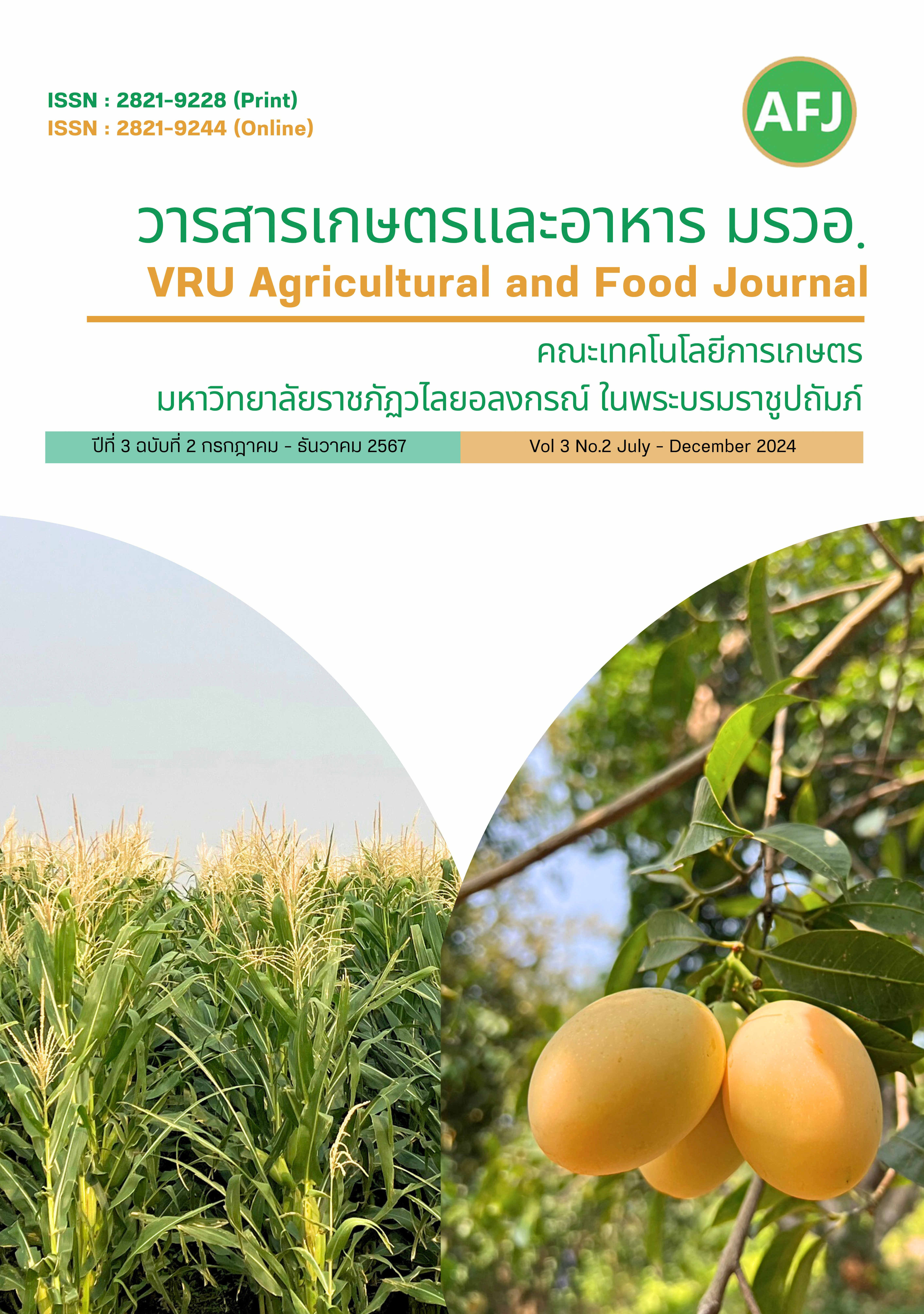ประสิทธิภาพการพ่นสารป้องกันกำจัดโรคราแป้งที่เกิดจากเชื้อรา Oidium sp. ต่อผลผลิตของพันธุ์ถั่วเขียว
Main Article Content
บทคัดย่อ
การทดลองนี้มีวัตถุประสงค์เพื่อศึกษาประสิทธิภาพการพ่นสารเคมีป้องกันกำจัดโรคราแป้งในถั่วเขียวพันธุ์ต่าง ๆ วางแผนการทดลองแบบ Split plot in RCB จำนวน 4 ซ้ำ ปัจจัยหลัก คือ จำนวนครั้งของการพ่นสารเคมีเบโนมิล 50% WP อัตรา 20 กรัมต่อน้ำ 20 ลิตร ได้แก่ (1) พ่นหลังพบการเป็นโรค จำนวน 1 ครั้ง (2) หลังพบการเป็นโรค จำนวน 3 ครั้ง และ (3) ไม่พ่นสารเคมี ปัจจัยรอง คือ พันธุ์ถั่วเขียว ได้แก่ (1) กำแพงแสน 2 (2) กวก.ชัยนาท 3 (3) กวก.ชัยนาท 72 (4) กวก.ชัยนาท 84-1 (5) KUML4 และ (6) KUML8 ผลการทดลอง พบว่า พันธุ์ถั่วเขียวไม่มีปฏิสัมพันธ์กับการควบคุม โรคราแป้งโดยใช้สารเคมี ซึ่งถั่วเขียวทุกพันธุ์มีระดับความรุนแรงของการเกิดโรคราแป้งไม่แตกต่างทางสถิติ แต่การพ่นสารเคมีทุก 7 วัน จำนวน 3 ครั้ง พบการเป็นโรคราแป้งต่ำสุดคือ 29.0 เปอร์เซ็นต์ของพื้นที่ใบ และผลผลิตทุกพันธุ์ให้ผลผลิตเฉลี่ยไม่แตกต่างกัน แต่การพ่นสารเคมีทุก 7 วัน จำนวน 3 ครั้งให้ผลผลิตถั่วเขียวสูงสุดเท่ากับ 127 กิโลกรัมต่อไร่ สามารถลดการสูญเสียผลผลิตจากโรคราแป้งได้ 46 เปอร์เซ็นต์
Article Details

อนุญาตภายใต้เงื่อนไข Creative Commons Attribution-NonCommercial-NoDerivatives 4.0 International License.
บทความนี้ได้รับการเผยแพร่ภายใต้สัญญาอนุญาต Creative Commons Attribution-NonCommercial-NoDerivatives 4.0 International (CC BY-NC-ND 4.0) ซึ่งอนุญาตให้ผู้อื่นสามารถแชร์บทความได้โดยให้เครดิตผู้เขียนและห้ามนำไปใช้เพื่อการค้าหรือดัดแปลง หากต้องการใช้งานซ้ำในลักษณะอื่น ๆ หรือการเผยแพร่ซ้ำ จำเป็นต้องได้รับอนุญาตจากวารสารเอกสารอ้างอิง
Ngampongsai, S., S. Srisombun and P. Srinives. 2004. Mungbean Mutants Multi-location Trial: Thailand. Paper Presented at the IAEA/RAC Project Progress reviewing Meeting on Mutants Multi-location Trials and Mutation Enhancement of Genetic Diversity. 29 October-3 November 2004. Republic of Korea.
Office of Agricultural Economics. 2023. Information on the Situation of Mung Bean Production. (in Thai)
Phruetthithep, C., S. Ngampongsai and A. Masari. 2012. The Loss of Mungbeam Yield Due to Powdery Mildew Infection. Pages 259-262. In: Proceedings of the 4th National Legume Crop Conference. August 27-29, 2013. Sampran Riverside Hotel, Sam Phran District, Nakhon Pathom Province. (in Thai)
Plant Pathology and Department of Microbiology. 2002. Handbook of Field Crop Diseases. Academic Document of the Plant Disease and Microbiology Division, Department of Agriculture, Ministry of Agriculture and Cooperatives, Bangkok. 105 p. (in Thai)
Surin, P and A. Chinswangwatanakul. 1987. Development of Sampling Models for Assessing Major Diseases of Mungbean. Pages 92-99. In: Annual Research Report 1987, Plant Pathology and Microbiology Division, Department of Agriculture. (in Thai)
Soria, J.A. and F.C. Quebral. 1973. Occurrence and development of powdery mildew on mungbean. Philippine Agric. 57: 158-177.
Tantanapornkul, N., S. Wongkaew and P. Laosuwan. 2005. Effects of powdery mildew on yield, yield components and seed quality of mungbeans. Suranaree J. Sci. Technol. 13(12): 159-162.


